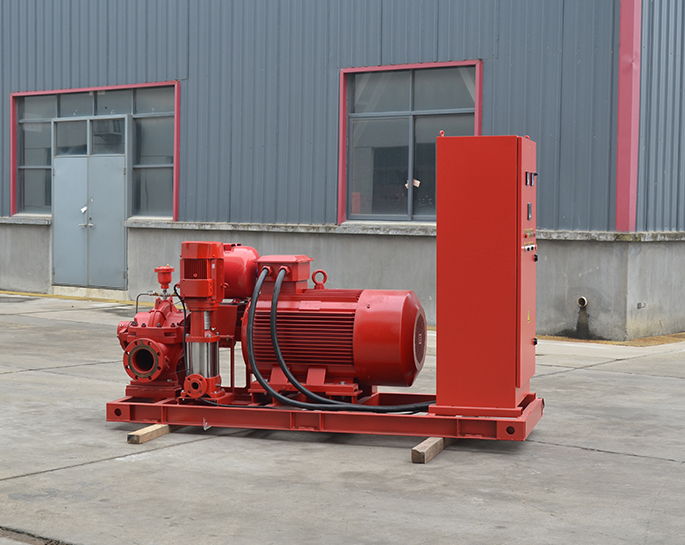How can users ensure the long-term reliability and performance of electric fire pumps beyond the initial installation?
Mar 28, 2024
Share:
Ensuring the long-term reliability and performance of electric fire pumps requires regular maintenance, monitoring, and adherence to best practices. Here are some steps users can take:
1. **Scheduled Maintenance**: Implement a comprehensive maintenance schedule that includes regular inspections, testing, and servicing of electric fire pumps. This should adhere to manufacturer recommendations and industry standards. Key maintenance tasks may include checking electrical connections, lubricating moving parts, testing control systems, and inspecting pump performance.
2. **Training and Certification**: Ensure that personnel responsible for maintaining and operating electric fire pumps are adequately trained and certified. This may involve attending training courses provided by the pump manufacturer or relevant industry organizations. Well-trained personnel can identify issues early, perform maintenance tasks correctly, and respond effectively during emergencies.
3. **Monitoring Systems**: Install monitoring systems that continuously track the performance and condition of electric fire pumps. This may include sensors for temperature, pressure, vibration, and flow rate. Monitoring systems can provide early warnings of potential problems, allowing for timely intervention and preventive maintenance.
4. **Backup Power Supply**: Install backup power systems, such as uninterruptible power supplies (UPS) or standby generators, to ensure uninterrupted operation of electric fire pumps during power outages. Backup power sources should be regularly tested to verify their reliability and functionality.
5. **Environmental Considerations**: Protect electric fire pumps from environmental factors that could affect their performance and longevity. This may involve proper ventilation to prevent overheating, protection from water ingress or flooding, and shielding from dust, debris, or corrosive substances.
6. **Documentation and Record-Keeping**: Maintain detailed records of maintenance activities, inspections, tests, and repairs performed on electric fire pumps. This documentation helps track the pump's history, identify recurring issues, and ensure compliance with regulatory requirements.
7. **Regular Testing and Exercising**: Conduct regular testing and exercising of electric fire pumps to verify their readiness for emergency operation. This includes full-load testing, flow testing, and performance testing according to relevant standards and guidelines. Testing should be conducted by qualified personnel and documented accordingly.
8. **System Upgrades and Improvements**: Stay informed about advancements in pump technology and fire protection standards. Consider upgrading electric fire pumps or associated components to improve efficiency, reliability, and compliance with regulations.
By implementing these measures, users can help ensure the long-term reliability and performance of electric fire pumps, minimizing the risk of failure and maintaining effective fire protection capabilities. Regular maintenance, monitoring, and proactive management are essential for safeguarding life and property in the event of a fire.

1. **Scheduled Maintenance**: Implement a comprehensive maintenance schedule that includes regular inspections, testing, and servicing of electric fire pumps. This should adhere to manufacturer recommendations and industry standards. Key maintenance tasks may include checking electrical connections, lubricating moving parts, testing control systems, and inspecting pump performance.
2. **Training and Certification**: Ensure that personnel responsible for maintaining and operating electric fire pumps are adequately trained and certified. This may involve attending training courses provided by the pump manufacturer or relevant industry organizations. Well-trained personnel can identify issues early, perform maintenance tasks correctly, and respond effectively during emergencies.
3. **Monitoring Systems**: Install monitoring systems that continuously track the performance and condition of electric fire pumps. This may include sensors for temperature, pressure, vibration, and flow rate. Monitoring systems can provide early warnings of potential problems, allowing for timely intervention and preventive maintenance.
4. **Backup Power Supply**: Install backup power systems, such as uninterruptible power supplies (UPS) or standby generators, to ensure uninterrupted operation of electric fire pumps during power outages. Backup power sources should be regularly tested to verify their reliability and functionality.
5. **Environmental Considerations**: Protect electric fire pumps from environmental factors that could affect their performance and longevity. This may involve proper ventilation to prevent overheating, protection from water ingress or flooding, and shielding from dust, debris, or corrosive substances.
6. **Documentation and Record-Keeping**: Maintain detailed records of maintenance activities, inspections, tests, and repairs performed on electric fire pumps. This documentation helps track the pump's history, identify recurring issues, and ensure compliance with regulatory requirements.
7. **Regular Testing and Exercising**: Conduct regular testing and exercising of electric fire pumps to verify their readiness for emergency operation. This includes full-load testing, flow testing, and performance testing according to relevant standards and guidelines. Testing should be conducted by qualified personnel and documented accordingly.
8. **System Upgrades and Improvements**: Stay informed about advancements in pump technology and fire protection standards. Consider upgrading electric fire pumps or associated components to improve efficiency, reliability, and compliance with regulations.
By implementing these measures, users can help ensure the long-term reliability and performance of electric fire pumps, minimizing the risk of failure and maintaining effective fire protection capabilities. Regular maintenance, monitoring, and proactive management are essential for safeguarding life and property in the event of a fire.







